AMD Ryzen 5 3600 Review: Why Is This Amazon's Best Selling CPU?
by Dr. Ian Cutress on May 18, 2020 9:00 AM ESTCPU Performance: Synthetic, Web and Legacy Tests
While more the focus of low-end and small form factor systems, web-based benchmarks are notoriously difficult to standardize. Modern web browsers are frequently updated, with no recourse to disable those updates, and as such there is difficulty in keeping a common platform. The fast paced nature of browser development means that version numbers (and performance) can change from week to week. Despite this, web tests are often a good measure of user experience: a lot of what most office work is today revolves around web applications, particularly email and office apps, but also interfaces and development environments. Our web tests include some of the industry standard tests, as well as a few popular but older tests.
We have also included our legacy benchmarks in this section, representing a stack of older code for popular benchmarks.
All of our benchmark results can also be found in our benchmark engine, Bench.
GeekBench4: Synthetics
A common tool for cross-platform testing between mobile, PC, and Mac, GeekBench 4 is an ultimate exercise in synthetic testing across a range of algorithms looking for peak throughput. Tests include encryption, compression, fast Fourier transform, memory operations, n-body physics, matrix operations, histogram manipulation, and HTML parsing.
I’m including this test due to popular demand, although the results do come across as overly synthetic, and a lot of users often put a lot of weight behind the test due to the fact that it is compiled across different platforms (although with different compilers).
We record the main subtest scores (Crypto, Integer, Floating Point, Memory) in our benchmark database, but for the review we post the overall single and multi-threaded results.
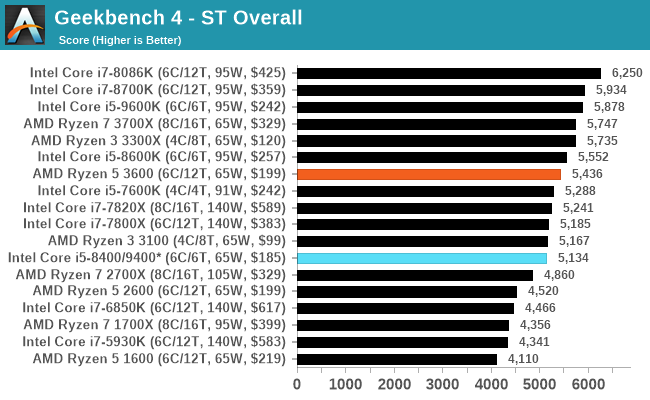
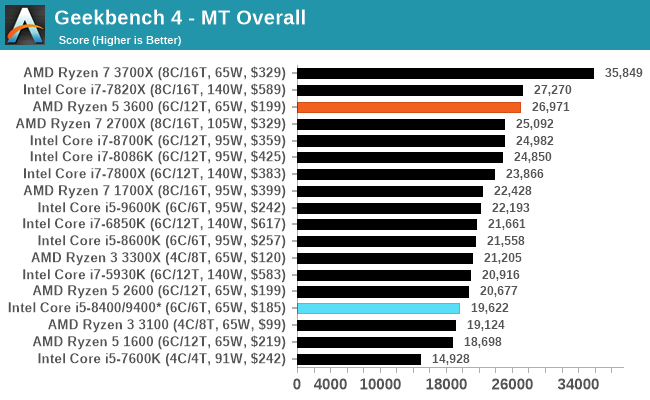
Speedometer 2: JavaScript Frameworks
Our newest web test is Speedometer 2, which is a accrued test over a series of javascript frameworks to do three simple things: built a list, enable each item in the list, and remove the list. All the frameworks implement the same visual cues, but obviously apply them from different coding angles.
Our test goes through the list of frameworks, and produces a final score indicative of ‘rpm’, one of the benchmarks internal metrics. We report this final score.

Google Octane 2.0: Core Web Compute
A popular web test for several years, but now no longer being updated, is Octane, developed by Google. Version 2.0 of the test performs the best part of two-dozen compute related tasks, such as regular expressions, cryptography, ray tracing, emulation, and Navier-Stokes physics calculations.
The test gives each sub-test a score and produces a geometric mean of the set as a final result. We run the full benchmark four times, and average the final results.
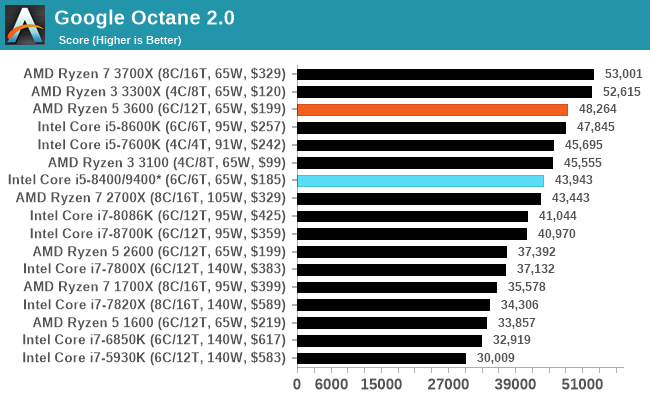
Mozilla Kraken 1.1: Core Web Compute
Even older than Octane is Kraken, this time developed by Mozilla. This is an older test that does similar computational mechanics, such as audio processing or image filtering. Kraken seems to produce a highly variable result depending on the browser version, as it is a test that is keenly optimized for.
The main benchmark runs through each of the sub-tests ten times and produces an average time to completion for each loop, given in milliseconds. We run the full benchmark four times and take an average of the time taken.
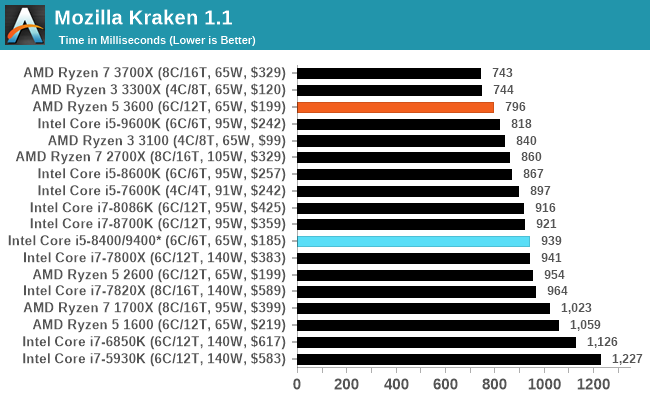
3DPM v1: Naïve Code Variant of 3DPM v2.1
The first legacy test in the suite is the first version of our 3DPM benchmark. This is the ultimate naïve version of the code, as if it was written by scientist with no knowledge of how computer hardware, compilers, or optimization works (which in fact, it was at the start). This represents a large body of scientific simulation out in the wild, where getting the answer is more important than it being fast (getting a result in 4 days is acceptable if it’s correct, rather than sending someone away for a year to learn to code and getting the result in 5 minutes).
In this version, the only real optimization was in the compiler flags (-O2, -fp:fast), compiling it in release mode, and enabling OpenMP in the main compute loops. The loops were not configured for function size, and one of the key slowdowns is false sharing in the cache. It also has long dependency chains based on the random number generation, which leads to relatively poor performance on specific compute microarchitectures.
3DPM v1 can be downloaded with our 3DPM v2 code here: 3DPMv2.1.rar (13.0 MB)
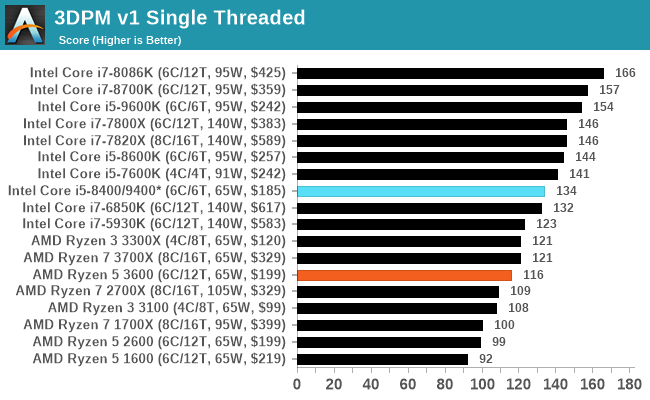
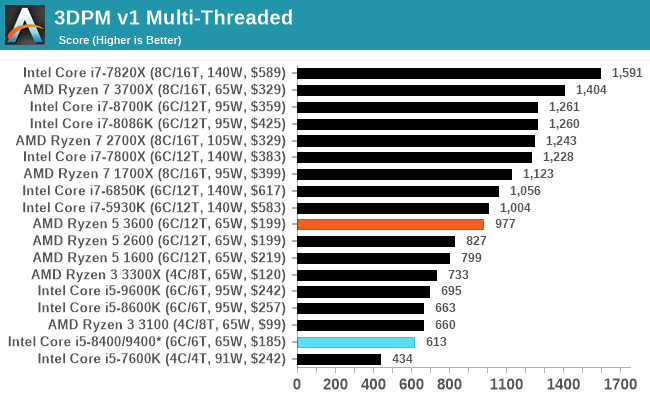
x264 HD 3.0: Older Transcode Test
This transcoding test is super old, and was used by Anand back in the day of Pentium 4 and Athlon II processors. Here a standardized 720p video is transcoded with a two-pass conversion, with the benchmark showing the frames-per-second of each pass. This benchmark is single-threaded, and between some micro-architectures we seem to actually hit an instructions-per-clock wall.

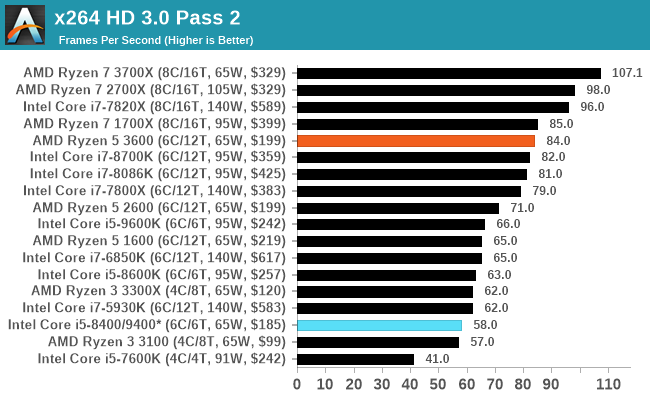










114 Comments
View All Comments
steve wilson - Tuesday, May 19, 2020 - link
They do it to make it a fair test. You can easily compare results of other CPU's if you are using the same hardware in the rest of the PC.Meteor2 - Wednesday, May 20, 2020 - link
I was almost that person asking that question; thank you for pointing out a good answer.Irata - Tuesday, May 19, 2020 - link
It is interesting for the average $ 150- 200 CPU buyer since they most likely won‘t have anything close to a 2080ti in their PC.Personally, I also think all reviews should be done using the stock heatsink or alternatively add the aftermarket HSF‘s price to the CPU cost, at least in the low to mid range.
Spunjji - Tuesday, May 19, 2020 - link
How does that better help you evaluate the performance? All it does is tell you what you'd see if you spend $1200 on a GPU and then restrict yourself to last decade's favourite resolution. The differences you observe in that state don't translate to meaningful performance difference in practice.TheJian - Tuesday, May 19, 2020 - link
Scanned page titles, no OCing, crap benchmarks....Moving along.Spunjji - Tuesday, May 19, 2020 - link
We already know that there's not really any point in overclocking Ryzen. Why waste the time on repeating that?msroadkill612 - Tuesday, May 19, 2020 - link
Ian makes an important point imo - the 3600 has been the cheapest foot in the door for zen2. It happens to also be a very muscular 6 core.Folks are starting to get that its about balance, & the whole am4 zen ecosystem leaves Intel for dead.
A little mentioned thing, is intel must run NVME drives thru the chipset - yuk... thats not the same at all - its wasting a lot of what u paid for that boon of a resource.
watzupken - Tuesday, May 19, 2020 - link
Performance vs price is certainly the key reason for people to get the Ryzen 5 3600. At least for myself, I tend to get mid tier CPUs as I don't like to spend too much on a hardware. Historically, I would get Intel i5 consistently due to it price vs performance. I feel most people will be on this same boat where we look for best performance to price. In the case of AMD Ryzen 5 3600, it's got an outstanding value since it performs better than an Intel chip at the same price, and you can further overclock it to push performance. Intel chips at this price point means an OC locked chip.johnthacker - Tuesday, May 19, 2020 - link
So basically, as expected, the Ryzen 3 3300X is the 5 3600's equal on anything that's not embarrassingly parallel, but the 5 3600 is far superior on things like encoding, decoding, and compression that parallelize easily.Oxford Guy - Tuesday, May 19, 2020 - link
"AMD Ryzen 5 3600 Review: Why Is This Amazon's Best Selling CPU?"Lame headline. How about this:
"Stomped: AMD Ryzen 5 3600 Has No Intel Competition In Its Price Bracket"
My headline is more to the point.